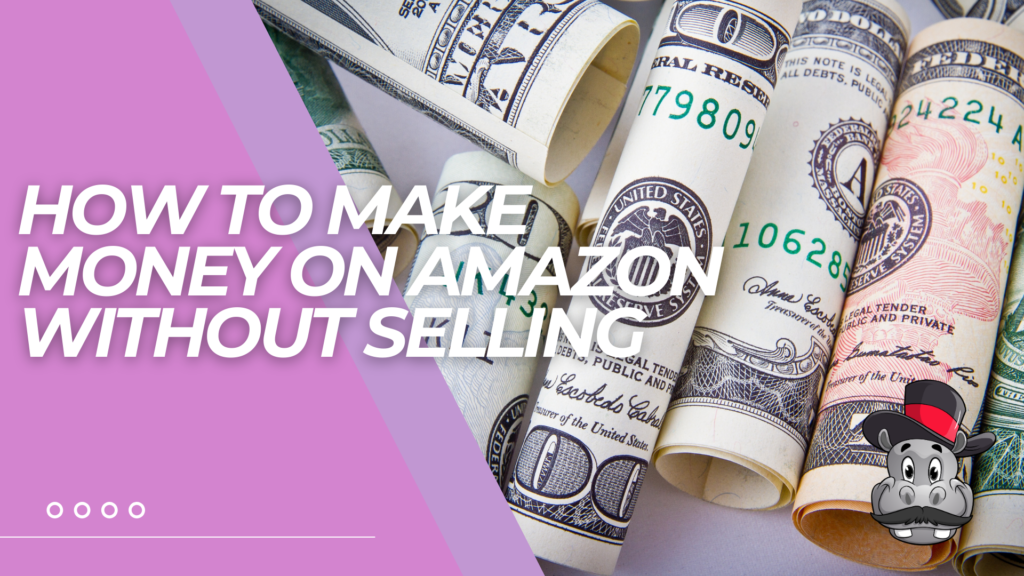This post may contain affiliate links. This means I will make a commission at no extra cost to you should you click through and make a purchase. Read the full disclosure HERE.
INTRODUCTION:
As an aspiring seller on the Amazon platform, there are various strategies and tips that can help you achieve success. From choosing the right products to optimizing your listings and utilizing Amazon advertising, each step plays a crucial role in your overall success. Here are some essential tips to be successful on Amazon.
1. Choosing the Right Products to Sell
2. Creating an Effective Amazon Seller Account
3. Optimizing Product Listings
4. Utilizing Amazon Advertising
5. Managing Inventory and Fulfillment
6. Providing Excellent Customer Service
7. Monitoring and Adjusting Your Selling Strategy
By following these tips and implementing effective strategies, you can increase your chances of achieving success as an Amazon seller and maximize your potential on the platform.
Key takeaways:
- Choosing the right products is crucial: Research market demand, assess competition, and evaluate profitability to ensure successful selling on Amazon.
- Optimize your product listings: Craft optimized titles, write compelling descriptions, utilize high-quality images, implement relevant keywords, and utilize enhanced brand content to attract customers.
- Monitor and adjust your selling strategy: Track sales metrics, analyze competitor performance, and respond to market trends to stay ahead on Amazon.
1. Choosing the Right Products to Sell
When it comes to succeeding on Amazon, choosing the right products to sell can make all the difference. In this section, we’ll explore key strategies to help you navigate this crucial step. From researching market demand to assessing competition and evaluating profitability, we’ll arm you with the tools and knowledge needed to make informed decisions. So, let’s dive in and discover how to maximize your potential for success in the Amazon marketplace!
Researching Market Demand
- Researching market demand is essential for successful sales on Amazon.
- To identify popular product categories, utilize tools such as Jungle Scout or Helium 10.
- Analyze product ratings, customer feedback, and sales data to assess demand.
- Take into account seasonal trends and fluctuations in demand.
- Look for untapped niches or unique product variations to differentiate yourself.
To excel on Amazon, it is crucial to consistently monitor market demand, adapt your product selection, and stay ahead of competitors. Stay well-informed about industry trends and customer preferences to maximize sales and profitability.
Assessing Competition
| Factors to Consider when Assessing Competition |
| 1. Market Share |
| 2. Pricing Strategies |
| 3. Product Differentiation |
| 4. Customer Reviews and Ratings |
| 5. Marketing and Advertising Campaigns |
Assessing competition on Amazon involves analyzing market share, pricing strategies, product differentiation, customer reviews and ratings, and marketing campaigns.
Did you know that approximately 90% of all customers read online reviews before making a purchase decision?
Evaluating Profitability
When selling on Amazon, it is crucial to evaluate profitability. There are several key factors that need to be considered:
- Product Cost: It is important to calculate all expenses involved in sourcing, manufacturing, and shipping.
- Sales Volume: You need to determine the potential demand for the product and estimate the number of units you can sell.
- Selling Fees: It is essential to understand the fees associated with Amazon selling plans, referral fees, and FBA fees.
- Competition: It is necessary to research competitors’ prices, sales volume, and customer reviews to gauge market saturation.
- Profit Margin: You should analyze the potential profit margin after deducting all costs and fees.
2. Creating an Effective Amazon Seller Account
When it comes to becoming successful on Amazon, it all starts with setting up an effective seller account. In this section, we’ll dive into the nitty-gritty of creating a compelling presence on Amazon. From setting up your seller central account to selecting the right selling plan and understanding Amazon’s rules and policies, we’ll equip you with the knowledge and tools you need to thrive in the realm of e-commerce giants. Time to transform your business and make your mark on Amazon!
Setting Up Your Seller Central Account
- Go to the Amazon Seller Central website.
- Click on the “Register Now” button to create a new account.
- Provide all the required information, including your business name, address, and contact details.
- Choose the appropriate selling plan based on your business needs and budget.
- Read and agree to Amazon’s terms and conditions.
- Set up your payment method and choose how you want to get paid.
- Complete the tax information section, including providing your tax ID.
- Verify your email address by clicking on the confirmation link sent to your registered email.
- Set up your account preferences, such as language, currency, and shipping settings.
Selecting the Right Selling Plan
- When selecting the right selling plan on Amazon, consider your business goals and budget.
- Individual Selling Plan: Suitable for sellers with fewer than 40 sales per month, with a per-item fee for each sale.
- Professional Selling Plan: Ideal for high-volume sellers, with a monthly subscription fee and lower per-item fees.
- Evaluate the features and benefits offered by each plan to determine which one aligns with your selling needs.
- Take into account factors such as access to additional tools, eligibility for certain programs, and customer trust.
Understanding Amazon’s Rules and Policies
To achieve success on Amazon, it is of utmost importance to have a thorough comprehension of Amazon’s rules and policies. It is vital to familiarize yourself with their guidelines on account suspension, prohibited items, product listing requirements, and customer communication. Adhering to these guidelines is crucial in maintaining a positive selling experience. As a valuable tip, keep yourself informed about policy changes by consistently reviewing Amazon’s Seller Central resources.
3. Optimizing Product Listings
Crafting successful product listings on Amazon requires strategic optimization. In this section, we will uncover the secrets to maximizing your product’s visibility and boosting sales. From crafting irresistible titles to writing compelling descriptions and utilizing high-quality images, we’ll explore the key components that will help your products stand out in the competitive marketplace. We’ll delve into the importance of implementing relevant keywords and utilizing Enhanced Brand Content to create a compelling and persuasive shopping experience for potential buyers. Get ready to elevate your Amazon game!
Crafting Optimized Titles
Crafting optimized titles for your Amazon listings is crucial for maximizing visibility and attracting potential customers. Here are some steps to create effective titles:
- Include relevant keywords strategically to improve search ranking.
- Keep the title concise and clear, focusing on the main features and benefits of your product.
- Utilize capitalization and formatting to highlight key information in your title.
- Avoid the use of excessive punctuation or special characters, as they can make the title appear spammy.
- Regularly monitor and adjust titles based on performance and market trends.
By following these steps, you can enhance your product visibility and increase your chances of success on Amazon.
Writing Compelling Product Descriptions
When writing compelling product descriptions on Amazon, it’s important to make them persuasive and attractive to potential buyers.
- Highlight the unique features and benefits of the product.
- Use descriptive language to create a vivid image in the customer’s mind.
- Focus on the problem that the product solves and how it improves the customer’s life.
- Incorporate keywords naturally to improve search rankings.
- Keep the description concise and easy to read, using bullet points or short paragraphs.
Writing compelling product descriptions can increase click-through rates and ultimately lead to more sales on Amazon.
Utilizing High-Quality Product Images
To create an impressive online presence on Amazon, sellers should prioritize utilizing high-quality product images. This can greatly impact customer perception and increase sales. Some tips to harness the potential of high-quality product images are:
- Invest in professional photography for crisp and well-lit images.
- Showcase multiple angles and features of the product.
- Use high-resolution images that can be zoomed in for clearer details.
- Ensure images accurately represent the product’s color, size, and texture.
- Utilize lifestyle images to demonstrate product use and create a connection with potential buyers.
Implementing Relevant Keywords
When selling on Amazon, incorporating relevant keywords is essential to enhance product discoverability and boost sales. Here are the steps to effectively implement relevant keywords:
- Conduct Research: Carry out thorough keyword research to identify the most pertinent and popular keywords for your product.
- Strategic Placement: Strategically place keywords in your product title, bullet points, product description, and backend search terms.
- Ensure Relevance: Make sure that the keywords you utilize accurately depict your product and align with customer search queries.
- Embrace Variation: Utilize a combination of long-tail and short-tail keywords to cater to different search intents and attract a broader audience.
- Monitor and Adjust: Continuously monitor the performance of keywords and make necessary adjustments based on search volume, competition, and customer behavior.
Utilizing Enhanced Brand Content
Utilizing Enhanced Brand Content on Amazon allows sellers to enhance their product listings and provide customers with a more immersive shopping experience.
- Create visually appealing product descriptions and images to showcase the unique features and benefits of your brand.
- Utilize multimedia elements like videos and interactive images to engage customers and communicate the value of your products.
- Highlight your brand story, values, and customer testimonials to build trust and differentiate your products from competitors.
- Incorporate product comparisons, sizing guides, and FAQs to address customer concerns and help them make informed purchasing decisions.
- Optimize keywords and search terms to improve discoverability and increase organic traffic to your product pages.
4. Utilizing Amazon Advertising
Looking to boost your success on Amazon? Look no further than utilizing Amazon Advertising. In this section, we’ll dive into the power of Sponsored Products, Sponsored Brands, and Sponsored Display. Get ready to discover how these advertising tools can elevate your online presence, increase visibility, and drive sales on the world’s largest e-commerce platform. It’s time to take your Amazon game to the next level with targeted advertising strategies that deliver results.
Sponsored Products
- Sponsored products on Amazon are a form of advertising that allows sellers to promote their products.
- These ads appear in search results and on product detail pages, increasing visibility and driving traffic to the seller’s listing.
- Sellers pay a fee for each click on their sponsored ad, and the ad placement is determined by bidding on keywords.
- By utilizing sponsored products, sellers can effectively target their audience, increase sales, and gain a competitive edge.
- The use of Sponsored Products on Amazon serves as a means of advertising where sellers can effectively promote their products.
- These Sponsored Products are featured in search results and on product detail pages, providing greater visibility and generating traffic towards the seller’s listing.
- Sellers incur a fee for each click on their sponsored ad, and the placement of the advertisement is determined through keyword bidding.
- By leveraging Sponsored Products, sellers can accurately target their desired audience, enhance sales, and secure a competitive advantage.
Brands
- Sponsored Brands are a type of Amazon advertising that allows sellers to promote their brand and products.
- They appear in prominent positions on search results pages and help increase brand visibility and recognition.
- With Sponsored Brands, sellers can showcase multiple products and create customizable headline text to engage customers.
To maximize the effectiveness of Sponsored Brands, sellers should:
- Choose relevant keywords that align with their target audience.
- Create compelling and attention-grabbing headlines.
- Optimize product images to attract customer attention.
- Monitor and analyze campaign performance to make data-driven decisions and adjust strategies accordingly.
By utilizing Sponsored Brands effectively, sellers can drive more traffic to their products and increase their sales on Amazon.
Sponsored Display
- Sponsored Display is an advertising feature offered by Amazon that allows sellers to promote their products through display ads on and off the Amazon platform.
- These ads reach potential customers as they browse websites, apps, or search on Amazon, increasing brand awareness and driving traffic to product listings.
- Sellers can target specific audiences based on interests, behaviors, or previous interactions with their brand.
- The ads are cost-per-click, meaning sellers only pay when a user clicks on their ad.
- To make the most of Sponsored Display, sellers should carefully select their targeting options, create compelling ad content, and continually monitor and optimize their campaigns.
To maximize the effectiveness of Sponsored Display, sellers can regularly analyze their campaign data, test different targeting options and ad creatives, and make adjustments based on performance metrics. By consistently refining their advertising strategy, sellers can boost product visibility, increase sales, and drive business growth on Amazon.
5. Managing Inventory and Fulfillment
Mastering inventory management and fulfillment is key to achieving success as a seller on Amazon. In this section, we will uncover the secrets to effectively managing your inventory and ensuring seamless order fulfillment. Discover the art of selecting the perfect fulfillment method tailored to your business needs, while also gaining insights into efficiently monitoring your inventory levels. By understanding these essential components, you can streamline your operations, maximize customer satisfaction, and ultimately thrive in the competitive Amazon marketplace.
Choosing the Right Fulfillment Method
- When choosing the right fulfillment method, consider your business requirements and goals.
- It’s important to evaluate the pros and cons of each fulfillment method.
- Fulfillment by Amazon (FBA) offers convenience and access to Prime customers, which can be beneficial for your business.
- On the other hand, fulfillment by Merchant (FBM) allows for greater control and customization, giving you more flexibility.
- Make sure to weigh factors such as storage fees, shipping costs, and order volume to make an informed decision.
Monitoring Inventory Levels
Monitoring inventory levels is crucial for a successful selling strategy on Amazon. Here are some steps to ensure effective inventory management:
- Track Sales Metrics: Regularly monitor inventory levels and sales data to understand product demand and forecast future inventory needs.
- Utilize Inventory Management Tools: Take advantage of Amazon’s inventory management tools to monitor inventory levels, track stock levels, set replenishment alerts, and avoid stockouts.
- Implement Just-in-Time Restocking: Maintain optimal inventory levels by adopting a just-in-time restocking approach to minimize storage costs and improve cash flow.
6. Providing Excellent Customer Service
When it comes to being successful on Amazon, one crucial aspect is providing excellent customer service. In this section, we’ll uncover the secrets to satisfying customers and building a loyal following. From responding promptly to customer inquiries and reviews to handling returns and refunds seamlessly, we’ll explore the key strategies that will set you apart from the competition. So buckle up, because we’re about to dive into the world of exceptional customer service on Amazon.
Responding to Customer Inquiries and Reviews
When it comes to responding to customer inquiries and reviews on Amazon, responding promptly and personally is essential. It is crucial to prioritize addressing customer questions and concerns in a professional manner, as well as actively seeking feedback to enhance your product and service. By effectively addressing customer inquiries and reviews, you can establish trust, improve customer satisfaction, and enhance your reputation as an Amazon seller.
Handling Returns and Refunds
When it comes to handling returns and refunds on Amazon, there are a few important steps to follow:
| Have a clear and transparent return policy in place.Provide prompt and responsive customer service to address any concerns or issues.Verify the condition of returned items before issuing a refund.Process refunds in a timely manner to ensure customer satisfaction.Track return and refund metrics to identify any patterns or areas of improvement. |
7. Monitoring and Adjusting Your Selling Strategy
Keeping a close eye on your selling strategy is the key to success on Amazon. In this section, we’ll dive into the nitty-gritty of monitoring and adjusting your approach to maximize profits. From tracking sales metrics to analyzing competitor performance and staying in tune with market trends, we’ll equip you with essential insights to sharpen your selling game. Prepare to unleash the power of data and fine-tune your strategy for optimal results in the competitive realm of Amazon.
Tracking Sales Metrics
| Tracking Sales Metrics – Total Sales | Monitor overall sales performance. |
| Tracking Sales Metrics – Conversion Rate | Measure the percentage of visitors who make a purchase. |
| Tracking Sales Metrics – Average Order Value | Track the average amount customers spend per order. |
| Tracking Sales Metrics – Customer Acquisition Cost | Calculate the expenses incurred to acquire a new customer. |
| Tracking Sales Metrics – Return on Investment | Evaluate the profitability of your selling strategies. |
Analyzing Competitor Performance
| Key Aspects of Analyzing Competitor Performance | |
| Sales Metrics: | Track competitor sales data to gain insights into their performance and market demand. |
| Product Offerings: | Evaluate the range of products offered by competitors and identify gaps in the market for potential opportunities. |
| Pricing: | Analyze competitor pricing strategies to ensure your prices remain competitive without sacrificing profitability. |
| Marketing and Advertising: | Examine competitor marketing tactics, such as advertising campaigns and promotions, to identify effective strategies for your own business. |
In order to succeed on Amazon, it is crucial to regularly assess competitor performance and adjust your selling strategy accordingly. Analyzing sales metrics, product offerings, pricing, and marketing strategies can provide valuable insights to help you stay ahead in the competitive marketplace.
Responding to Market Trends
To stay successful on Amazon, it’s crucial to respond to market trends by actively monitoring and adapting to them. It is important to keep an eye on customer preferences, industry developments, and competitor strategies in order to stay ahead. Regularly analyze sales metrics and make necessary adjustments to your selling strategy accordingly. In this dynamic marketplace, it is imperative to be proactive and adaptable to maintain an edge. Stay alert, stay ahead by always responding to market trends effectively.
Some Facts About Tips To Be Successful On Amazon:
- ✅ Amazon has a large customer base of 300 million shoppers worldwide.
- ✅ Amazon selling partners in the U.S. sell an average of 7,500 products per minute.
- ✅ Amazon and third-party lending partners lent $1.4 billion to small- and medium-sized businesses in the U.S. in 2021.
- ✅ The Amazon Best Sellers list can be used to see what products are already performing well and understand their appeal to buyers.
- ✅ Identifying a specific niche can help target a particular audience, but it may limit the range of products offered.
Frequently Asked Questions
How can I boost my profits as an Amazon seller?
To boost profits as an Amazon seller, you can:
- Identify profitable items by analyzing selling reports and maximizing your return on investment.
- Optimize your pricing strategy by finding a balance between being the most expensive and too low-priced.
- Strategically approach pricing by adjusting prices based on the value of the goods and competition, and considering popular strategies like raising prices when competitors run out.
What is the significance of Amazon selling partners in achieving success?
Amazon selling partners play a crucial role in achieving success as they contribute to a large customer base of 300 million shoppers worldwide. Collaborating with these partners allows you to tap into a wider audience and boost online sales.
How can I find the sweet spot for pricing my products on Amazon?
To find the sweet spot for pricing your products on Amazon:
- Research competition and compare listing descriptions and prices.
- Avoid being the most expensive or too low-priced.
- Consider using repricing software to dynamically adjust your prices based on market conditions.
What are the 10 tips for selling successfully on Amazon?
The 10 tips for selling successfully on Amazon are:
- Figure out what products to sell by exploring personal interests and strengths.
- Use the Amazon Best Sellers list to identify top-performing products.
- Consider factors like price, reviews, seasonality, and size when analyzing top-selling products.
- Identify a specific niche to target a particular audience, but be aware of potential limitations.
- Validate product ideas using a guide or business ideas for inspiration.
- Familiarize yourself with Amazon’s search engine algorithm to optimize search terms, keywords, and copywriting.
- Research competition, compare listing descriptions and prices to improve your ranking.
- Price items competitively based on the value of the goods and competition.
- Provide excellent customer service, accurate order information, appropriate packaging, and timely shipping.
- Abide by Amazon’s rules and guidelines to avoid account suspension.
How can Fulfilment by Amazon (FBA) benefit my business as an Amazon seller?
Fulfilment by Amazon (FBA) can benefit your business as an Amazon seller by:
- Simplifying the handling of returns through Amazon’s efficient process.
- Providing easy access to a large customer base of 300 million customers worldwide.
- Streamlining order fulfillment with Amazon’s world-class logistics network.
How can I effectively list items on Amazon to enhance visibility and sales?
To effectively list items on Amazon and enhance visibility and sales:
- Research competition and compare listing descriptions and prices to improve your ranking.
- Use Amazon SEO techniques to optimize search terms, keywords, and copywriting.
- Ensure your pricing strategy is competitive to attract potential buyers.
- Follow Amazon’s guidelines for correct listing information and adhere to the rules of the specific category you are selling in.
- Monitor and adjust your listings regularly to maintain relevance and maximize sales.





Pingback: Buying And Reselling On Amazon - Hippo Dollar
Pingback: Write Your Way to Financial Freedom: Making Money Online as a Freelance Writer - Hippo Dollar
Pingback: Selling Clearance Items On Amazon - Hippo Dollar
Pingback: How To Resell Items On Amazon | Hippo Dollar
Pingback: Brickseek Walmart Clearance | Hippo Dollar
Pingback: Maximize Your Profits Selling Used Books on Amazon | Hippo Dollar
Pingback: Maximize Amazon Seller Efficiency with Software Tools | Hippo Dollar
Pingback: How To Make Money On Amazon Without Selling | Hippo Dollar